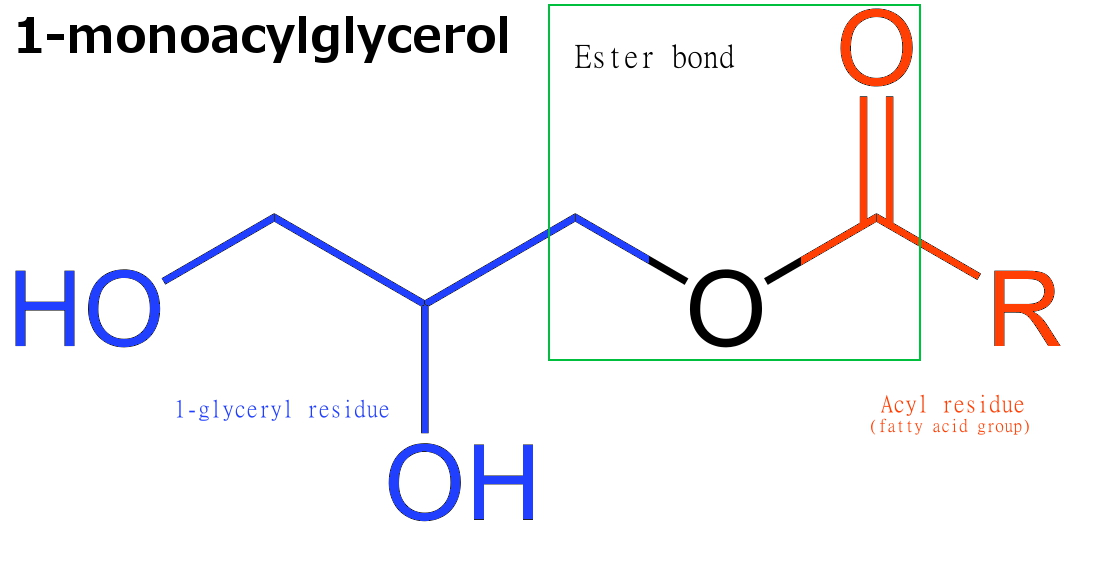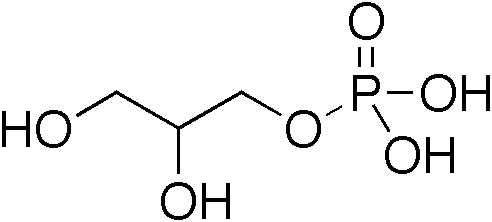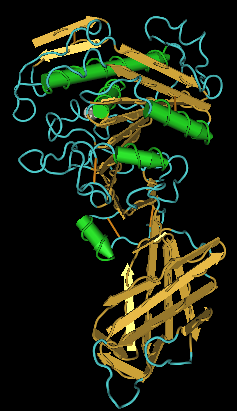|
Glyceride
Glycerides, also known as acylglycerols, are esters formed from glycerol and fatty acids, and are generally very hydrophobic. Glycerol has three hydroxyl functional groups, which can be esterified with one, two, or three fatty acids to form mono-, di-, and triglycerides. These structures vary in their fatty acid alkyl groups as they can contain different carbon numbers, different degrees of unsaturation, and different configurations and positions of olefins. Vegetable oils and animal fats contain mostly triglycerides, but are broken down by natural enzymes (lipases) into mono and diglycerides and free fatty acids and glycerol. Soaps are formed from the reaction of glycerides with sodium hydroxide. The product of the reaction is glycerol and salts of fatty acids. Fatty acids in the soap emulsify the oils in dirt, enabling the removal of oily dirt with water. Partial glycerides are esters of glycerol with fatty acids, where not all the hydroxyl groups are esterified. Since ... [...More Info...] [...Related Items...] OR: [Wikipedia] [Google] [Baidu] |
Triglyceride
A triglyceride (from '' tri-'' and '' glyceride''; also TG, triacylglycerol, TAG, or triacylglyceride) is an ester derived from glycerol and three fatty acids. Triglycerides are the main constituents of body fat in humans and other vertebrates as well as vegetable fat. They are also present in the blood to enable the bidirectional transference of adipose fat and blood glucose from the liver and are a major component of human skin oils. Many types of triglycerides exist. One specific classification focuses on saturated and unsaturated types. Saturated fats have ''no'' C=C groups; unsaturated fats feature one or more C=C groups. Unsaturated fats tend to have a lower melting point than saturated analogues; as a result, they are often liquid at room temperature. Chemical structure The three fatty acids substituents can be the same, but they are usually different. The positions of the three fatty acids are specified using stereospecific numbering as sn-1, sn-2, and sn- ... [...More Info...] [...Related Items...] OR: [Wikipedia] [Google] [Baidu] |
Triglycerides
A triglyceride (from ''wikt:tri-#Prefix, tri-'' and ''glyceride''; also TG, triacylglycerol, TAG, or triacylglyceride) is an ester derived from glycerol and three fatty acids. Triglycerides are the main constituents of body fat in humans and other vertebrates as well as vegetable fat. They are also present in the blood to enable the bidirectional transference of Adipose tissue, adipose fat and blood glucose from the liver and are a major component of sebum, human skin oils. Many types of triglycerides exist. One specific classification focuses on Saturated and unsaturated compounds, saturated and unsaturated types. Saturated fats have ''no'' C=C groups; unsaturated fats feature one or more C=C groups. Unsaturated fats tend to have a lower melting point than saturated analogues; as a result, they are often liquid at room temperature. Chemical structure The three fatty acids substituents can be the same, but they are usually different. The positions of the three fatty acids a ... [...More Info...] [...Related Items...] OR: [Wikipedia] [Google] [Baidu] |
Lipids
Lipids are a broad group of organic compounds which include fats, waxes, sterols, fat-soluble vitamins (such as vitamins Vitamin A, A, Vitamin D, D, Vitamin E, E and Vitamin K, K), monoglycerides, diglycerides, phospholipids, and others. The functions of lipids include storing energy, lipid signaling, signaling, and acting as structural components of cell membranes. Lipids have applications in the Cosmetic industry, cosmetic and Food industry, food industries, and in nanotechnology. Lipids are broadly defined as Hydrophobe, hydrophobic or Amphiphile, amphiphilic small molecules; the amphiphilic nature of some lipids allows them to form structures such as vesicle (biology), vesicles, multilamellar/unilamellar liposomes, or membranes in an aqueous environment. Biological lipids originate entirely or in part from two distinct types of biochemical subunits or "building-blocks": :wikt:ketoacyl, ketoacyl and isoprene groups. Using this approach, lipids may be divided into eight catego ... [...More Info...] [...Related Items...] OR: [Wikipedia] [Google] [Baidu] |
Monoglyceride
Monoglycerides (also: acylglycerols or monoacylglycerols) are a class of glycerides which are composed of a molecule of glycerol linked to a fatty acid via an ester bond. As glycerol contains both primary and secondary alcohol groups two different types of monoglycerides may be formed; 1-monoacylglycerols where the fatty acid is attached to a primary alcohol, or a 2-monoacylglycerols where the fatty acid is attached to the secondary alcohol. Synthesis Monoglycerides are produced both biologically and industrially. They are naturally present at very low levels (0.1-0.2%) in some seed oils such as olive oil, rapeseed oil and cottonseed oil. They are biosynthesized by the enzymatic hydrolysis of triglycerides by lipoprotein lipase and the enzymatic hydrolysis of diglycerides by diacylglycerol lipase; or as an intermediate in the alkanoylation of glycerol to form fats. Several monoglycerides are pharmacologically active (e.g. 2-oleoylglycerol, 2-arachidonoylglycerol). Industrial pro ... [...More Info...] [...Related Items...] OR: [Wikipedia] [Google] [Baidu] |
Diglyceride
A diglyceride, or diacylglycerol (DAG), is a glyceride consisting of two fatty acid chains covalently bonded to a glycerol molecule through ester linkages. Two possible forms exist, 1,2-diacylglycerols and 1,3-diacylglycerols. Diglycerides are natural components of food fats, though minor in comparison to triglycerides. DAGs can act as surfactants and are commonly used as emulsifiers in processed foods. DAG-enriched oil (particularly 1,3-DAG) has been investigated extensively as a fat substitute due to its ability to suppress the accumulation of body fat; with total annual sales of approximately USD 200 million in Japan since its introduction in the late 1990s till 2009. Production Diglycerides are a minor component of many seed oils and are normally present at ~1–6%; or in the case of cottonseed oil as much as 10%. Industrial production is primarily achieved by a glycerolysis reaction between triglycerides and glycerol. The raw materials for this may be either vegetable oil ... [...More Info...] [...Related Items...] OR: [Wikipedia] [Google] [Baidu] |
Fatty Acid
In chemistry, in particular in biochemistry, a fatty acid is a carboxylic acid with an aliphatic chain, which is either saturated and unsaturated compounds#Organic chemistry, saturated or unsaturated. Most naturally occurring fatty acids have an Branched chain fatty acids, unbranched chain of an even number of carbon atoms, from 4 to 28. Fatty acids are a major component of the lipids (up to 70% by weight) in some species such as microalgae but in some other organisms are not found in their standalone form, but instead exist as three main classes of esters: triglycerides, phospholipids, and cholesteryl esters. In any of these forms, fatty acids are both important diet (nutrition), dietary sources of fuel for animals and important structural components for cell (biology), cells. History The concept of fatty acid (''acide gras'') was introduced in 1813 by Michel Eugène Chevreul, though he initially used some variant terms: ''graisse acide'' and ''acide huileux'' ("acid fat" and "oi ... [...More Info...] [...Related Items...] OR: [Wikipedia] [Google] [Baidu] |
Animal Fat
Animal fats are lipids derived from animals which are used by the animal for a multitude of functions, or can be used by humans for dietary, sanitary, and cosmetic purposes. Depending on the temperature of the fat, it can change between a solid state and a liquid ( oil) state. Chemically, both fats and oils are composed of triglycerides. Although many animal parts and secretions may yield oil, in commercial practice, oil is extracted primarily from rendered tissue fats from livestock animals like pigs, chickens and cows. Dairy products yield animal fat and oil products such as butter. Chemical structure Animal fats are composed of triglycerides, which are a type of ester molecule in which glycerol is bonded to three fatty acids. The three fatty acids that bond to the glycerol will determine the complexity and type of the triglyceride. If the three fatty acids are the same, then the triglyceride will be considered a simple triglyceride. However, most triglycerides contain diff ... [...More Info...] [...Related Items...] OR: [Wikipedia] [Google] [Baidu] |
Lipase
In biochemistry, lipase ( ) refers to a class of enzymes that catalyzes the hydrolysis of fats. Some lipases display broad substrate scope including esters of cholesterol, phospholipids, and of lipid-soluble vitamins and sphingomyelinases; however, these are usually treated separately from "conventional" lipases. Unlike esterases, which function in water, lipases "are activated only when adsorbed to an oil–water interface". Lipases perform essential roles in digestion, transport and processing of dietary lipids in most, if not all, organisms. Structure and catalytic mechanism Classically, lipases catalyse the hydrolysis of triglycerides: \begin \text + \ce &\longrightarrow \text + \text \\[4pt] \text + \ce &\longrightarrow \text + \text \\[4pt] \text + \ce &\longrightarrow \text + \text \end Lipases are serine hydrolases, i.e. they function by transesterification generating an acyl serine intermediate. Most lipases act at a specific position on the glycerol ... [...More Info...] [...Related Items...] OR: [Wikipedia] [Google] [Baidu] |
Glycerin Skelett2
Glycerol () is a simple triol compound. It is a colorless, odorless, sweet-tasting, viscous liquid. The glycerol backbone is found in lipids known as glycerides. It is also widely used as a sweetener in the food industry and as a humectant in pharmaceutical formulations. Because of its three hydroxyl groups, glycerol is miscible with water and is hygroscopic in nature. Modern use of the word glycerine (alternatively spelled glycerin) refers to commercial preparations of less than 100% purity, typically 95% glycerol. Structure Although achiral, glycerol is prochiral with respect to reactions of one of the two primary alcohols. Thus, in substituted derivatives, the stereospecific numbering labels the molecule with a ''sn''- prefix before the stem name of the molecule. Production Natural sources Glycerol is generally obtained from plant and animal sources where it occurs in triglycerides, esters of glycerol with long-chain carboxylic acids. The hydrolysis, saponification, or trans ... [...More Info...] [...Related Items...] OR: [Wikipedia] [Google] [Baidu] |
Emulsion
An emulsion is a mixture of two or more liquids that are normally Miscibility, immiscible (unmixable or unblendable) owing to liquid-liquid phase separation. Emulsions are part of a more general class of two-phase systems of matter called colloids. Although the terms ''colloid'' and ''emulsion'' are sometimes used interchangeably, ''emulsion'' should be used when both phases, dispersed and continuous, are liquids. In an emulsion, one liquid (the dispersed phase (matter), phase) is dispersion (chemistry), dispersed in the other (the continuous phase). Examples of emulsions include vinaigrettes, homogenized milk, liquid biomolecular condensates, and some cutting fluids for metal working. Two liquids can form different types of emulsions. As an example, oil and water can form, first, an oil-in-water emulsion, in which the oil is the dispersed phase, and water is the continuous phase. Second, they can form a water-in-oil emulsion, in which water is the dispersed phase and oil is the ... [...More Info...] [...Related Items...] OR: [Wikipedia] [Google] [Baidu] |



